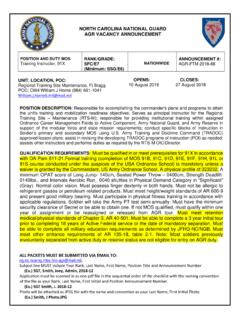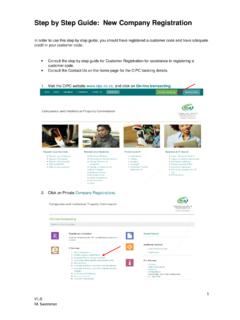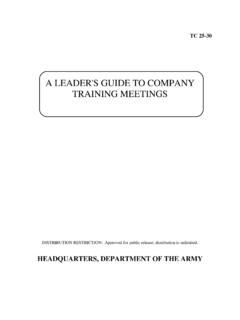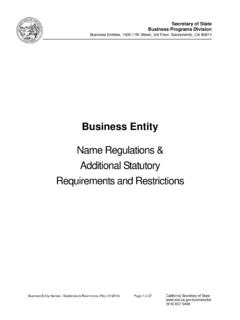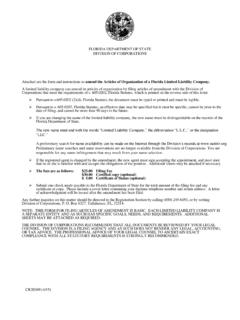Transcription of Company Training 101 - NCNG
1 August 2013. Company Training 101. Version 7. NCARNG G3-T. Company Training 101 August 2013. Table of Content OVERVIEW. Must Reads & Desk References 2. Requirement 2. Mission 2. Mission Focus and METL 3. End State 3. Company -LEVEL Training . Training Management Cycle 4. Digital Training Management System 4. Combined Arms Training Strategies 4. Training Meetings 5. Managing the Unit Training Plan 5. Successful Training Meetings 6. Participants 6. Training PLAN & CYCLE. Planning Process 9. Long-Range 9. Short-Range 10. Command Guidance 10. Year Training Briefs 10. Near-Term 11. Training Calendar Pen & Ink Changes 11.
2 Training Time-Line 12. Mandatory Training Requirement 15. HOW TO CONDUCT Training MEETINGS. Training Meeting Objectives 16. Training Meeting Time and Place 16. Training Meeting Agenda 17. Time Requirements 17. Phase I: Assessment 18. Phase II: Coordination 19. Possible Pre-Execution Checks 20. Phase III: Future Planning 22. Collective Task Crosswalk 23. Training Schedule Development 23. Monthly Training Schedule Checklist 24. Green-Amber-Red Time Management System 25. Additional Training Meeting Resources 27. NCARNG G3-T page 1. Company Training 101 August 2013. OVERVIEW. Must Reads & Desk References: 1.
3 Leader's guide to Company Training Meetings , US Army Combined Arms Center- Training Management Directorate (TMD) Army Training Network, 2. TC 25-30 A Leader's guide to Company Training Meetings, 30%20 Company %20 Training % 3. Army Publishing Directorate AR 350-1, 4. ADP/ADRP 7-0, Training Units and Developing Leaders (23 AUG 2012). 5. ADP/ADRP 6-22, Army Leadership (1 AUG 2012 w/c1). 6. AR 350-10, Management of Individual Training Requirements and Resources (3. SEP 2009) 7. JFHQ-NC-350-1. lations/JFHQ-NC%20 Regulations_Pamphlets/350-1%20 JFHQ- NC%20 Reg%20dated%2001%20 July% 8. Training and Leaders' Development Guidance FY13-14.
4 %2013%2D004%20%28 TLDG%20FY13%2D14%29&FolderCTID=0x012000C 797. D230B3535B45B751FC225 ABBC781&View={30A1347F-AECA-4007-A832- C0F4 DBDDF54C}. Requirement All North Carolina Army National Guard commanders are required to execute, supervise, publish and protect against changes within 90 days of Annual Training (AT) and Inactive Duty Training (IDT). Per JFHQ-NC 350-1, chapter 3, paragraph Training schedules will be published for IDT and AT for each unit in the NCARNG at least 120. days in advance of scheduled Training periods with approval received at the unit level NLT 90 days prior to execution . Mission As commander's within the North Carolina Army National Guard, the Training and Leader's Development Guidance FY 13-14 directs that your mission will be to provide a ready team of Citizen Soldiers who are always ready and always there to protect and preserve the lives and property of North Carolina citizens, defend our nation, and secure our American way of life.
5 NCARNG G3-T page 2. Company Training 101 August 2013. Mission Focus and METL. Planning extends the mission-focus process that links the METL with the subsequent preparation, execution, and assessment of Training . Centralized, coordinated planning develops mutually supporting, METL based Training at all unit echelons. Planning involves continuous coordination from long-range planning, through short-range and near- term planning, and ultimately leads to Training execution. End State The NCARNG remains ready, reliable, and relevant; capable of providing manned, equipped, and trained forces for state and federal requirements; Our Soldiers and leaders are physically fit, mentally tough, confident, and competent to execute their prescribed missions.
6 NCARNG G3-T page 3. Company Training 101 August 2013. Company -LEVEL Training . Training Management Cycle The Training management cycle begins with the assignment of a wartime mission and the establishment of a mission essential task list (METL). Once the METL is developed, it becomes the Training focus for the unit, or the where we want to be in terms of Training proficiency. The Training management cycle continues with a Training assessment. This assessment is a where we are check in terms of Training proficiency for the unit. These two basic elements of the Training management cycle define the framework of the Training plan.
7 Knowing where you are ( Training assessment) and knowing where you are going (METL) are half the battle to conducting effective Training . The Training management cycle is a continuous cycle of planning, executing, and assessing. An important aspect of the cycle is the continuous use of feedback to refine the Training plan. This feedback takes many forms: personal observations, after-action reviews, and informal evaluations, to name just a few. A primary forum for the discussion of Training assessments is the Training meeting. Digital Training Management System (DTMS). The Digital Training Management System (DTMS) is a web based Commercial Off The Shelf (COTS) software product tied to a relational database and customized.
8 DTMS is also sometimes called Army Training Management System (ATMS); names are interchangeable. ATMS is the only official mechanism for tracking and scheduling Training . Optimized for use at Brigade and below, ATMS provides the ability to plan, resource and manage unit and individual Training at all levels. It compiles collective and individual tasks, weapons qualifications, Army Physical Fitness Tests (APFT), Equal Opportunity briefing, Prevention of Sexual Harassment, Resiliency/Suicide Training , AR. 350-1 mandatory Training and deployment tasks from "Enlistment to Retirement". ATMS. provides relevant Training products through frequent updates of approved collective and individual tasks, Combined Arms Training Strategy (CATS), the Army Universal Task List (AUTL) and the Universal Joint Task List (UJTL).
9 ATMS is also used to track important dates so that Command Visits from General Officers and the Command Staff can be organized efficiently. ATMS is the only official source for building and developing the units Training schedules. Commanders are the only individuals that can approve a Training schedule. Commanders can appoint individuals to review Training schedules but, if the Company commander has not signed the Training schedule, it has not been approved. Combined Arms Training Strategies (CATS). CATS are publications that provide commanders with a template for task-based, event- driven organizational Training .
10 They can be adapted to the unit's requirements based on the commander's assessment. There are two types of CATS's: those that are unique to a unit's type, and those that address a functional capability common to multiple units. NCARNG G3-T page 4. Company Training 101 August 2013. Training Meetings Company Training meetings are the key to keeping the unit Training plan (UTP) on course. They are non-negotiable, and provide the commander and other leaders visibility of the current state of unit Training readiness. Accordingly, they appear on the monthly Training schedule. Training meetings facilitate the top down/bottom-up flow of information.

